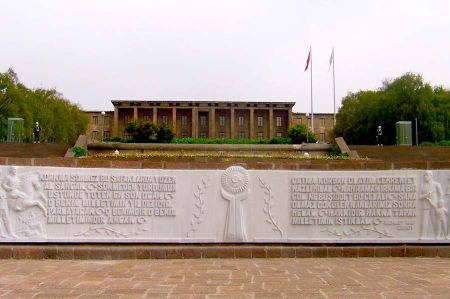Clemens Holzmeister - Architecture and Migration
- Written by Portal Editor
Our articles on Goethe Institute's book "The Development of a Capital – Traces of German-speaking Architects" and texts on Turkish architectural history ultimately led to getting to know and meeting the architect's daughter Barbara Mohapp in Vienna.
Ms. Mohapp was visibly pleased about the souvenir of this very book, which we were kindly able to present on behalf of the Goethe-Institut. Of course we were very excited to hear more details about the life of Clemens Holzmeister, who is well known in Turkey and is still highly valued as a master builder.
Made self-employed by growing coffee in Brazil
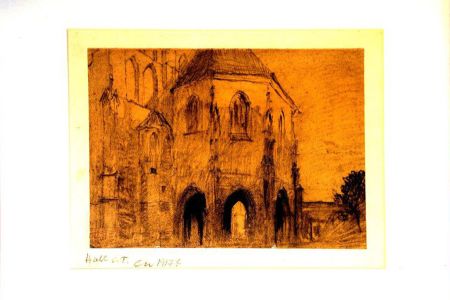 Right from the beginning of his life, the issue of migration played an almost as decisive role as architecture was later influential: Clemens Holzmeister was born on March 27, 1886 in Fulpmes in Tyrol as a Brazilian citizen. Clemens Holzmeister's grandfather, who came from a family of hammersmiths and wanted to emigrate to Brazil, is responsible for this. However, he died of cholera during the crossing, leaving behind a wife and seven children, who continued the journey to South America alone. The eldest son of this single woman was the future father of Clemens Holzmeister, who became self-employed by growing coffee in Brazil and later founded his own family.
Right from the beginning of his life, the issue of migration played an almost as decisive role as architecture was later influential: Clemens Holzmeister was born on March 27, 1886 in Fulpmes in Tyrol as a Brazilian citizen. Clemens Holzmeister's grandfather, who came from a family of hammersmiths and wanted to emigrate to Brazil, is responsible for this. However, he died of cholera during the crossing, leaving behind a wife and seven children, who continued the journey to South America alone. The eldest son of this single woman was the future father of Clemens Holzmeister, who became self-employed by growing coffee in Brazil and later founded his own family.
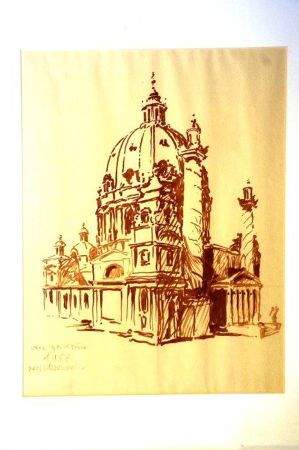 As was so often the case with immigrant families at the time, fate was not kind. Seven of his children died of malaria, also due to the climate. Holzmeister senior returned to Tyrol, had four more children there and married a second time after his first wife died. This marriage resulted in four more children, an unimaginable number of children today, the second eldest of whom was Clemens Holzmeister. After attending secondary school in Innsbruck, close friendship and discussions with a friend from Munich led to the realization that architecture and architecture could well become his profession. Clemens Holzmeister moved to Vienna, where he wanted to study architecture at the Technical University.
As was so often the case with immigrant families at the time, fate was not kind. Seven of his children died of malaria, also due to the climate. Holzmeister senior returned to Tyrol, had four more children there and married a second time after his first wife died. This marriage resulted in four more children, an unimaginable number of children today, the second eldest of whom was Clemens Holzmeister. After attending secondary school in Innsbruck, close friendship and discussions with a friend from Munich led to the realization that architecture and architecture could well become his profession. Clemens Holzmeister moved to Vienna, where he wanted to study architecture at the Technical University.
In 1913 Judith Bridarolli and Clemens Holzmeister married in Innsbruck and just one year later the first son Guido of this young family was born in Vienna. Until her marriage, Judith Bridarolli was a close friend of the famous mountaineer Luis Trenker, who was not only well acquainted with Clemens Holzmeister. Despite this "disengagement", Trenker and Holzmeister remained close friends throughout their lives. A year later, in 1920, their daughter Judith was born in Innsbruck.
Clemens Holzmeister was even able to successfully complete his architecture studies in Vienna in 1919 with a "Doctor of Technical Sciences" and immediately afterwards started teaching at the Innsbruck State Trade School. In the meantime, in addition to his work as a teacher, he also managed the installation business of his father-in-law Dominikus Bridarolli, which is now run by his great-grandchildren Norbert Engele and Thomas Engele. His first works in the field of architecture made his name known.
Crematorium next to the Vienna Central Cemetery
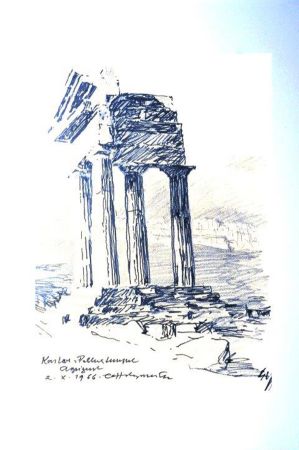 Clemens Holzmeister experienced his breakthrough as an architect with the completion of the crematorium built according to his designs next to the Vienna Central Cemetery, also known as the Simmering Fire Hall. As a result, Holzmeister was offered a professorship at the Vienna Academy of Fine Arts, which he held from 1924 to 1938. In addition, Clemens Holzmeister was also head of a master studio at the Düsseldorf Art Academy from 1928 to 1933. From 1932 to 1938 he was President of the Central Association of Architects and the New Austrian Werkbund.
Clemens Holzmeister experienced his breakthrough as an architect with the completion of the crematorium built according to his designs next to the Vienna Central Cemetery, also known as the Simmering Fire Hall. As a result, Holzmeister was offered a professorship at the Vienna Academy of Fine Arts, which he held from 1924 to 1938. In addition, Clemens Holzmeister was also head of a master studio at the Düsseldorf Art Academy from 1928 to 1933. From 1932 to 1938 he was President of the Central Association of Architects and the New Austrian Werkbund.
As early as 1927, Clemens Holzmeister was appointed to Ankara through the mediation of Mehmet Hamdi Bey, where he was commissioned to build the Turkish Ministry of War. From this period of his activities in Turkey, he was highly honored and subsequently also built a palatial villa as Atatürk's new residence, the seat of the President. In 1939 he separated from his first wife Judith. A little later, in Turkish exile, he married Gunda Lexer, who gave birth to his daughter Barbara in Athens. In 1939, Clemens Holzmeister spent another six months in Brazil to process orders before returning to Tyrol.
Moved to Istanbul-Tarabya in Turkey
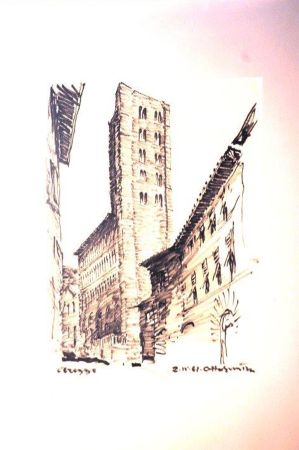 Due to the apparently unstoppable expansion of the National Socialist influence on Austria, Clemens Holzmeister was dismissed from the Vienna Academy of Fine Arts in 1938 because of his overly modern conception of architecture. He then finally emigrated to Istanbul-Tarabya in Turkey and began teaching at Istanbul Technical University in 1940. In the years that followed, Holzmeister commuted back and forth between Brazil, Turkey and Austria, where he carried out his commissions. His further teaching activities at the Technical University in Istanbul also survived the Second World War until 1949. However, Clemens Holzmeister moved to Ankara as early as 1947 and began to commute between Vienna and Ankara.
Due to the apparently unstoppable expansion of the National Socialist influence on Austria, Clemens Holzmeister was dismissed from the Vienna Academy of Fine Arts in 1938 because of his overly modern conception of architecture. He then finally emigrated to Istanbul-Tarabya in Turkey and began teaching at Istanbul Technical University in 1940. In the years that followed, Holzmeister commuted back and forth between Brazil, Turkey and Austria, where he carried out his commissions. His further teaching activities at the Technical University in Istanbul also survived the Second World War until 1949. However, Clemens Holzmeister moved to Ankara as early as 1947 and began to commute between Vienna and Ankara.
Although Clemens Holzmeister was officially rehabilitated after the end of the Second World War, he only finally returned to Austria in 1954, where he had already received the Grand Austrian State Prize in 1953. From 1955 to 1957 he was rector at the Academy of Fine Arts in Vienna. In 1957 he received the Austrian Decoration of Honor for Science and Art and the City of Vienna Prize for Architecture. In 1963 he received an honorary doctorate from Istanbul Technical University. For his 85th birthday he went on a study trip to Turkey.
Clemens Holzmeister was an important creator of monumental and sacred buildings. He developed a reinterpretation of local building traditions between simplicity and expressiveness. Clemens Holzmeister died on June 12, 1983 and is buried in the Petersfriedhof in Salzburg.
Austria
Sacred Buildings
Parish Church of St. John the Baptist, Batschuns (1921–1923) (between water)
Maria Hilf Monastery with the retreat house of the Missionaries of the Precious Blood in Kufstein (1923, 1928)
Extensions to the Obergurgl parish church in the municipality of Sölden (1924, 1966)
Mariahilf Parish Church (Heroes' Thanksgiving Church) in Bregenz (1925–1931), Vorarlberg
Krim parish church in Vienna-Döbling (1931/32)
Conversion and expansion of the Dornbach parish church in Vienna-Hernals (1931/32)
Conversion and expansion of the parish church of St. Anton am Arlberg (1932)
Branch Church of the Redeemer in Wiener Neustadt; Conversion of a factory hall into a church (1932)
Christ the King's Church of the Neufünfhaus Parish in Vienna (1932)
Parish Church of St. Erhard, Mauer (Vienna) (1934–36)
Branch church in Hollenstein near Ziersdorf (1936)
Evangelical Christ Church in Kitzbühel (1962)
Grave of the Krösbacher family in Innsbruck, Wilten Cemetery
Parish Church of All Saints-St. Georg, Hötting, Innsbruck (completed 1964)
Parish Church Pertisau, Tyrol (1966–1970)
Don Bosco Parish Church (Großfeldsiedlung) in Vienna-Floridsdorf (erected in 1971)
Guardian Angel Chapel on the Schlickeralm in the municipality of Telfes
Parish Church Erpfendorf, Tyrol
Bruckhäusl parish church near Wörgl, Tyrol
Church of Christ the King in Gloggnitz
Grafenstein mortuary (Carinthia) (1965)
St. Stephan parish church in Gmünd (Lower Austria), 1981-1982 extension
Parish Church in Zwölfaxing (1966–1967)
Branch church in Holzhausen, parish of Sankt Georgen near Salzburg, 1985 extension
Secular Buildings
Elementary school in Marbach an der Donau (first work)
Feuerhalle Simmering in Vienna (1921–22)
Sanatorium Mehrerau in Bregenz (1922–1923)
Hotel Steinbock in Steinach am Brenner (built in 1923; demolished in 1986)
Municipal building Blathof in Vienna (1924–1925)
Hotel Post in St. Anton am Arlberg (1927/28)
Cardinal Piffl Student Residence of Akademikerhilfe in Vienna (1931/32)
Kurhaus in Bad Ischl (1932)
2 houses in the Werkbundsiedlung Vienna (1932)
Memorial at the Fuschertörl, Grossglockner High Alpine Road (1933)
Funkhaus Argentinierstrasse in Vienna (1935–39)
Festspielhaus in Salzburg (1st conversion 1926; 2nd conversion 1936/38), see Small Festival Hall
State Theater in Linz (1953–1958)
Large Festival Hall in Salzburg (1955–1960)
School home Don Bosco in Fulpmes
Leopold-Figl-Warte at Tulbingerkogel Lower Austria (1966–67; opened 1968)
Grafenstein elementary school (Carinthia) (1969/71)
Elementary school in Jenbach, Tyrol
Culture hall at the elementary school in Himmelberg, Carinthia (1978/80)
Andreas Hofer monument in Vienna-Wieden on Südtiroler Platz (design; executed by Jakob Adlhart)
Germany
Sacred Buildings
Parish Church of St. Maria Himmelfahrt, Maria Grün, Hamburg-Blankenese, 1929–30
Hedwig's Cathedral, Berlin, expressionist conversion of the interior into a bishop's church, destroyed in the war
Parish Church of St. Peter, Mönchengladbach-Waldhausen, 1933
Church of St. Adalbert, Berlin-Mitte, 1933
Parish Church of St. Agatha, Merchingen
Catholic Parish Church of St. Martin, Nuremberg, Gardens behind the Veste district, 1934-1935,
Reconstruction according to a plan by Rolf Behringer 1946-1948
Christkönigskirche in Kleve on the Lower Rhine (1934), destroyed in 1944
St. Mary Magdalene, Brotdorf
Franciscan Monastery, Hermeskeil
Conversion in the Romanesque Church of St. George (Cologne)
Parish Church of the 12 Holy Apostles in Augsburg-Hochzoll, 1964-66
Secular Buildings
Schlageter National Monument, Düsseldorf-Golzheim, 1931 South Tyrol (Italy)
Hotel Drei Zinnen, Sesto, 1929–1931
Hotel Adler, Ortisei in Val Gardena, 1926 villa dr Runggaldier, Ortisei in Val Gardena, 1926
Villa Pretz, Bolzano, 1930
Conversion and expansion of the parish church of St. Vigil, Untermais, Meran
Türkiye (Ankara)
The building of the Grand National Assembly of Türkiye in Ankara
Department of Defense, 1927–30
Military Academy, 1930–35
City villa Ataturk, 1931–32
Central Bank (Merkez Bankası), 1931–33
"Monument of Trust" in Kızılay - Ankara
Emlak Bank, 1933–34
Supreme Court, 1933–34
Austrian Legation, 1933–34
Ministry of Economy and Agriculture, 1933–35
Ministry of the Interior, 1932–34
Parliament Buildings, 1938–63
Please read as well:
Exhibition on 40th anniversary of Clemens Holzmeister's death
